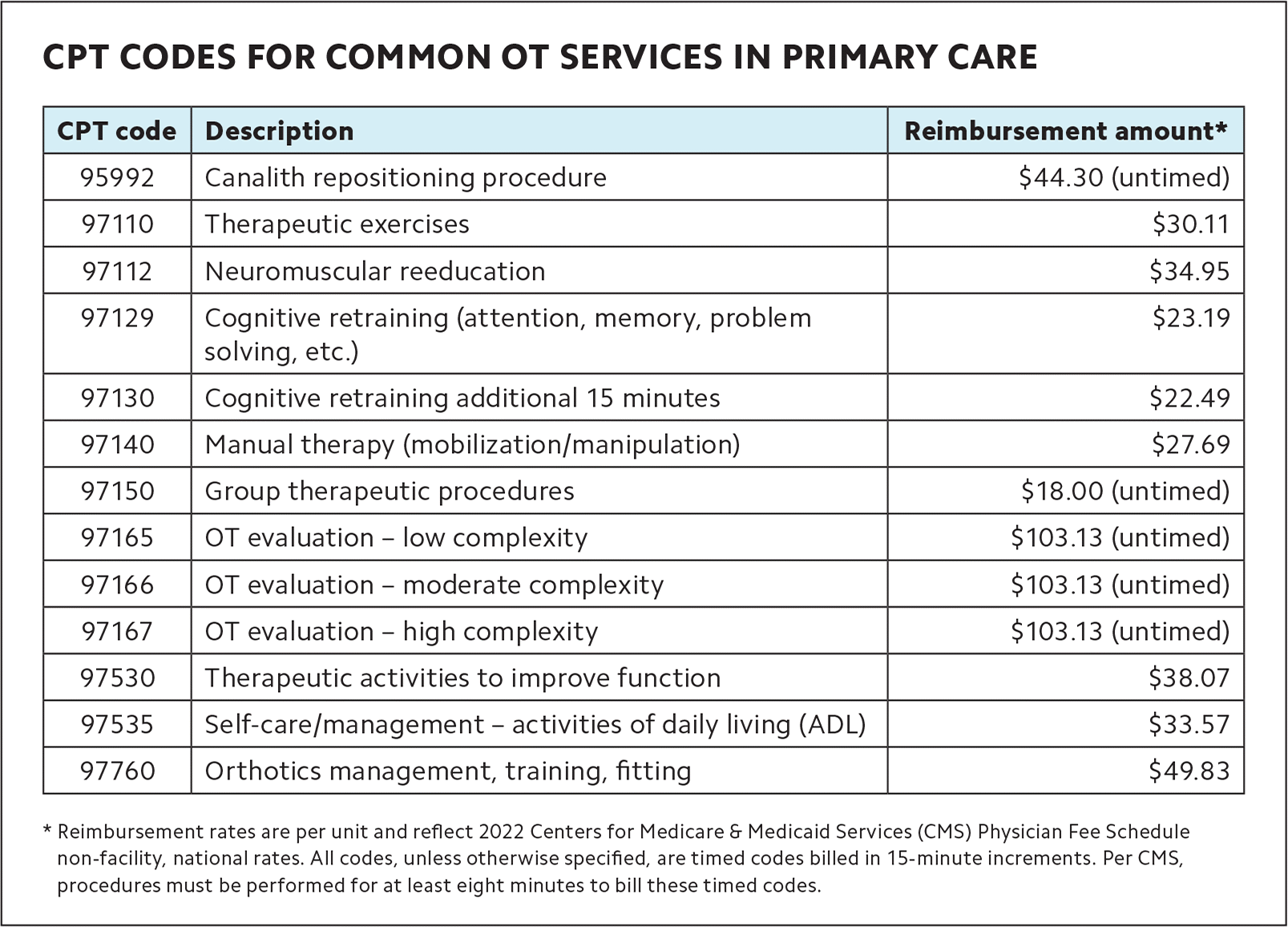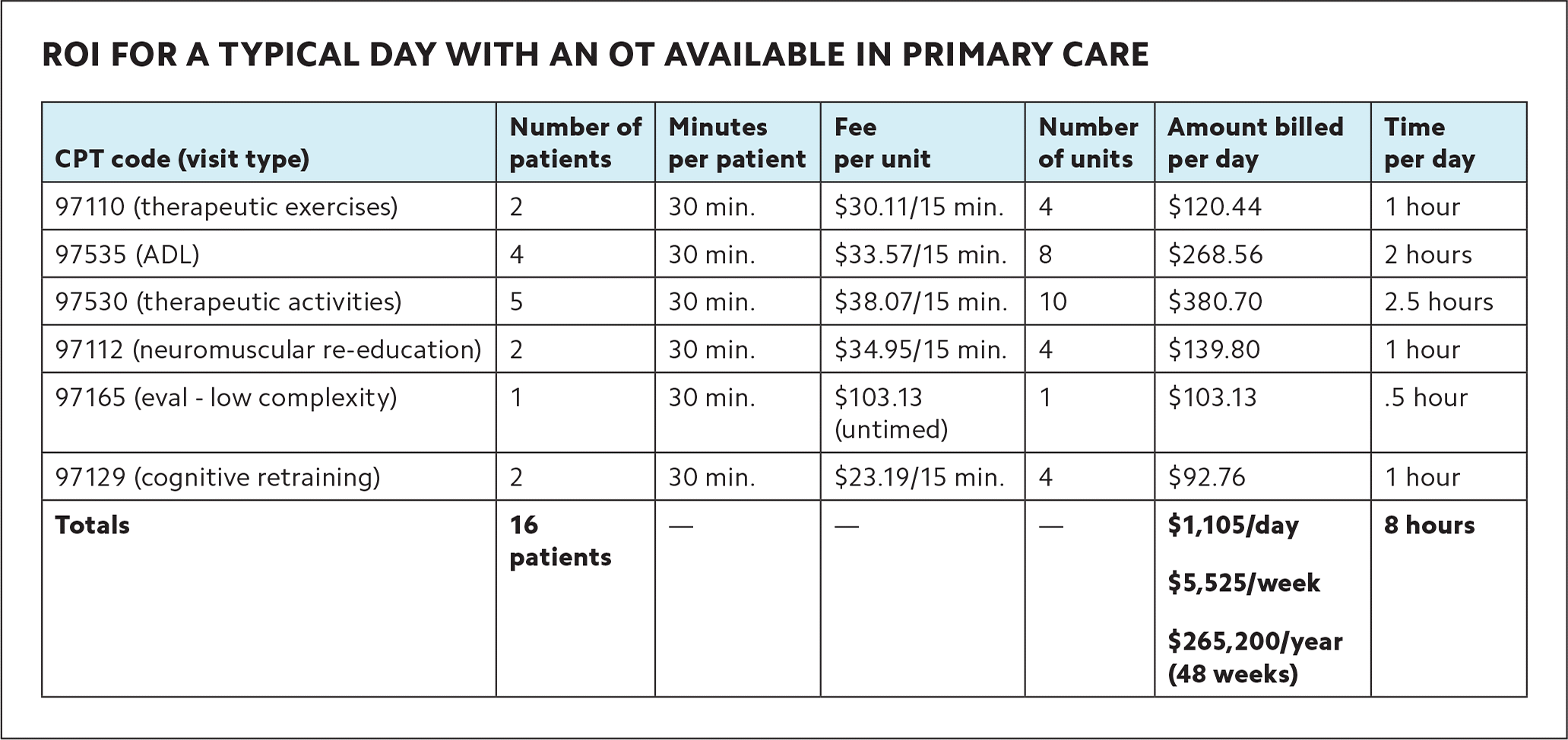
OTs can address patient issues that do not require the skill set of a physician, increasing physician availability for patients with more complex needs.
Fam Pract Manag. 2023;30(3):15-19
Author disclosures: no relevant financial relationships.

Using an interprofessional team in primary care has the potential to reduce physician workload, improve job satisfaction, and decrease burnout. Although the use of team-based care models is increasing, there is no standardization regarding which professionals should be on the team. As a result, some potentially useful team members, such as occupational therapists (OTs), are often overlooked.
When OTs are added to a health care team, they can help address issues that do not require the skill set of a physician, increasing the availability of physicians for patients who require complex medical decision making.1,2 OTs' education and training in mental/behavioral health, medical conditions, rehabilitation, and lifestyle management make them versatile members of the primary care team.2–4 OTs have a unique lens, viewing patients in the context of their environment, including their family role, employment, culture, and value system, as well as the habits, roles, and routines that comprise their daily lives.
A growing body of evidence supports the value and effectiveness of occupational therapy in primary care.1–4 Despite the benefits of including OTs on a primary care team, key barriers have been a lack of awareness of the full skill set OTs can contribute to the team and concerns about reimbursement for their services.
Our organization, Mayo Clinic of Arizona, piloted the use of an OT in a family medicine practice. This article shares our analysis of the pilot in an effort to address key barriers and help other practices assess whether their care teams could benefit from having an OT.
KEY POINTS
When OTs are added to the primary care team, they can address issues that do not require the skill set of a physician, increasing the availability of physicians for patients who require complex medical decision making.
OTs aim to improve physical and mental health function through the therapeutic use of “occupations” or everyday activities that are meaningful to the patient.
Key barriers to the use of OTs have been a lack of awareness of the full skill set they can contribute to the primary care team and concerns regarding reimbursement for their services.
OT EDUCATION AND TRAINING
The OT profession traces its roots to World War I, when the providers who would ultimately become OTs treated soldiers for their physical and psychological injuries. The OT profession has evolved over the years, expanding into multiple settings, but the foundational goal persists: improving physical and mental health function through the therapeutic use of “occupations” or everyday activities that are meaningful to the patient. OTs use a holistic approach to promote health, wellness, and prevention for people across the lifespan who experience injury, illness, and disability. OTs are trained to identify and address the physical, mental, and behavioral barriers impeding independence, including barriers to adherence.
According to the Accreditation Council for Occupational Therapy Education (ACOTE), educational curriculum requirements include substantial foundational knowledge in biological, physical, social, and behavioral sciences and how they impact function and occupation.5 OTs can obtain entry-level master's or doctoral degrees. Most programs require 24 weeks of fieldwork, and ACOTE requires at least one fieldwork experience at a site that addresses psychological or behavioral health issues. In addition, OTs in the U.S. must pass the National Board of Certification in Occupational Therapy examination and meet state licensing requirements for the individual states in which they practice.
OTs can specialize in several areas: hand and upper extremity (CHT), gerontology (BCG), mental health (BCMH), pediatrics (BCP), physical rehabilitation (BCPR), driving and community mobility (SCDCM or SCDCM-A), environmental modification (SCEM or SCEM-A), and feeding, eating, and swallowing (SCFES or SCFES-A).
OT REIMBURSEMENT AND COMMON SERVICES
Although health care is shifting away from fee-for-service reimbursement to alternative payment models, fee for service is still the norm for most primary care practices. Therefore, it is not surprising that concerns persist regarding reimbursement for occupational therapy services on a primary care team.2,3,6 To address this concern, we have identified the services our OT commonly provides in the primary care practice, the CPT codes billed, and the reimbursement amounts. (See the table below.)

| CPT code | Description | Reimbursement amount* |
|---|---|---|
| 95992 | Canalith repositioning procedure | $44.30 (untimed) |
| 97110 | Therapeutic exercises | $30.11 |
| 97112 | Neuromuscular reeducation | $34.95 |
| 97129 | Cognitive retraining (attention, memory, problem solving, etc.) | $23.19 |
| 97130 | Cognitive retraining additional 15 minutes | $22.49 |
| 97140 | Manual therapy (mobilization/manipulation) | $27.69 |
| 97150 | Group therapeutic procedures | $18.00 (untimed) |
| 97165 | OT evaluation – low complexity | $103.13 (untimed) |
| 97166 | OT evaluation – moderate complexity | $103.13 (untimed) |
| 97167 | OT evaluation – high complexity | $103.13 (untimed) |
| 97530 | Therapeutic activities to improve function | $38.07 |
| 97535 | Self-care/management – activities of daily living (ADL) | $33.57 |
| 97760 | Orthotics management, training, fitting | $49.83 |
Examples of services OTs can provide to support chronic disease management are as follows:
Provide individualized strategies for adherence to medications, treatment plans, diet modifications, or activity/exercise programs,
Provide education regarding self-care/management, such as activities of daily living (ADLs),
Address contributing behavioral health issues, such as depression and anxiety, and administer PHQ-9 or GAD-7 assessments as needed,
Discuss coping strategies for handling stress, life changes, bereavement, etc.,
Use behavioral strategies to support pharmacological strategies for smoking cessation.
Examples of services OTs can provide to support physical or rehabilitation issues are as follows:
Conduct a postural assessment and identify modifications to improve postural alignment, increase flexibility, and decrease complaints of pain,
Provide activity modification techniques,
Provide general exercise education,
Discuss coping strategies for loss of function, loss of employment, loss of meaningful recreation, or change in family roles.
PHYSICIAN SATISFACTION AND ROI
Our original six-month pilot program to add an OT to a primary care team has evolved into a permanent full-time OT position. This is largely due to success in two areas: physician satisfaction with the model and the return on investment.
Physician satisfaction. We surveyed the primary care physicians and other providers involved in the pilot before implementation and 18 months after implementation. When asked how much they agreed with the statement “There is a need for OT services in the primary care practice,” only 13% agreed or strongly agreed before implementation, but 96% agreed or strongly agreed post-implementation. When asked “How important do you feel it is to have OT integrated into the primary care practice?” 87% in the initial survey stated it was of average importance and none said it was absolutely essential, but in the post-implementation survey 61% said it was absolutely essential and 30% said it was very important.
Additionally, primary care physicians and other providers reported that having an OT on site to immediately address patients' needs decreased their stress and increased their job satisfaction. With the ability to hand off a patient directly to the OT, the physicians felt confident the referral would be completed, the patient would receive timely care, and the OT would provide timely updates on the patient.
Detailed tracking of patient outcomes was beyond the scope of this pilot study. However, a review of patient charts and therapy notes indicated that a majority of patients referred to the OT reported either partial (30%) or complete (54%) improvement. Only 3% did not report improvement, and 13% were lost to follow up. It is possible that those lost to follow up improved sufficiently that they did not feel they required further care.
Return on investment. According to the Bureau of Labor and Statistics, the average salary for an OT in 2021 was $85,570 per year, which we estimate would be roughly $112,952 with full employee benefits. The potential revenue is $265,200 (see the calculation in the table below). The ROI is calculated as follows: profit ($265,200 - $112,952) divided by cost ($112,952) equals 1.35 — or a 135% return on investment.
This calculation does not include the additional revenue from physicians being more available to see patients with complex medical needs. It also does not include the cost of supplies such as braces, slings, and prefabricated splints or orthoses (many of which are reimbursable), adaptive equipment for use in treatment interventions, or assessment/evaluation equipment (which is typically a one-time expense if the equipment is not already available, e.g., through Physical Medicine or Rehabilitation departments).
ROI FOR A TYPICAL DAY WITH AN OT AVAILABLE IN PRIMARY CARE

| CPT code (visit type) | Number of patients | Minutes per patient | Fee per unit | Number of units | Amount billed per day | Time per day |
|---|---|---|---|---|---|---|
| 97110 (therapeutic exercises) | 2 | 30 min. | $30.11/15 min. | 4 | $120.44 | 1 hour |
| 97535 (ADL) | 4 | 30 min. | $33.57/15 min. | 8 | $268.56 | 2 hours |
| 97530 (therapeutic activities) | 5 | 30 min. | $38.07/15 min. | 10 | $380.70 | 2.5 hours |
| 97112 (neuromuscular re-education) | 2 | 30 min. | $34.95/15 min. | 4 | $139.80 | 1 hour |
| 97165 (eval - low complexity) | 1 | 30 min. | $103.13 (untimed) | 1 | $103.13 | .5 hour |
| 97129 (cognitive retraining) | 2 | 30 min. | $23.19/15 min. | 4 | $92.76 | 1 hour |
| Totals | 16 patients | — | — | — | $1,105/day $5,525/week $265,200/year (48 weeks) | 8 hours |
KEYS TO IMPLEMENTATION
In our experience, keys to successful implementation of this model are as follows:
1. Co-locate the OT within the family medicine team. In our case, the team consisted of 15 physicians or other providers, one pharmacist, one complex care coordinator, as well as nursing and allied health staff. The OT had a dedicated workstation in a collaborative team room and shared a therapy gym with two physical therapists. OT consults took place in either the practice exam rooms or the therapy gym.
2. Give the OT their own schedule within the practice's system. All physicians or other providers should have viewing access, and the clinic administrative staff should handle scheduling the patients. Although the ideal schedule will vary based on setting, we recommend leaving every other OT appointment slot open during the day, as this allows for adequate availability for warm handoffs and ensures the OT is available to answer questions from team members throughout the day.
3. Refer patients to the OT through a warm handoff. This is simply a quick, in-person introduction. The actual OT visit can occur on the day of the patient's visit with the primary care physician or be scheduled within five days depending on patient and OT availability.
4. Have the OT participate in daily team huddles. This aids discussions about possible referrals as the team reviews the patients scheduled for the day.
5. Have the OT participate in department and population health meetings. The OT can present on various topics to help educate the team about the OT's role and which patients would benefit from referral.
Integrating OTs into primary care allows the team to address patients' needs related to habits, roles, routines, lifestyle choices, behaviors, and behavioral health all in one place where they most often present for care — the primary care setting. With their unique skill set, OTs can complement the other members of the primary care team. Practice leaders must ultimately decide which providers are optimal to serve the needs of their patients and their teams, but the information provided here can assist practices in determining if their primary care teams can benefit from the skill set of an OT.
